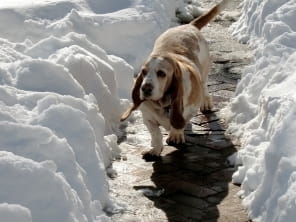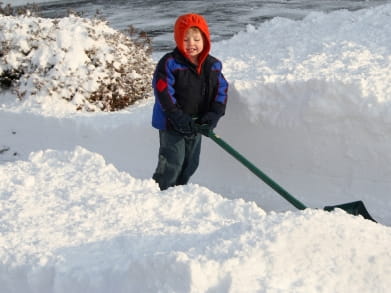Pets, Kids, and Ice Melt Products

The Bottom Line
Ice-melting chemicals commonly contain sodium chloride or rock salt, calcium chloride, potassium chloride, magnesium chloride, and/or urea, also known as carbonyl diamide. If swallowed, they can be irritating and cause stomach distress. On the skin or paws, they can cause irritation and dryness.

The Full Story
Crystals and granules intended to melt ice and snow keep walkways safe. But, like many useful chemicals, they can cause problems if they are misused.
Ice-melting chemicals commonly contain sodium chloride or rock salt, calcium chloride, potassium chloride, magnesium chloride, and/or urea, also known as carbonyl diamide. (Products intended to provide traction, instead of melting ice or snow, include sand, gravel, kitty litter, and wood ash.) These ice-melting chemicals lower the freezing point of water. Applying them on top of a layer of ice or snow results in slush. The slush then can be shoveled or pushed off the walkway.
Sodium chloride, the same thing as table salt, and calcium chloride are the products most often used by homeowners. The amount to use depends on the type of chemical. Labels will tell you how much product to use per foot or yard of surface. More is not better! Recommended amounts will produce the maximum effect with the minimum amount of damage to plants, concrete, cement, soil, and water.
Poison Control gets many calls about children who put ice melting crystals into their mouths. Usually, this does not cause problems. BUT, some of these chemicals can cause irritation; a child may develop a rash, redness inside the mouth, or drooling. If a child swallows a piece of rock salt or another ice melting crystal, wipe out the child's mouth, give a small glass of milk or water, and wash the child's hands and face. Then, use the webPOISONCONTROL® online tool or call Poison Control at 1-800-222-1222 for guidance.
Pets can develop dryness and irritation on their paws and skin if they walk through ice melting chemicals. Wipe all of the product off their paws and fur as soon as they come inside. Then, wash carefully to remove any residue. Pets can develop mouth irritation if they eat the chemicals or the resulting melt-water. They may even swallow enough sodium or calcium to poison themselves. If a pet develops drooling, vomiting, seizures, or other symptoms, call the veterinarian right away.
Rose Ann Gould Soloway, RN, BSN, MSEd, DABAT emerita
Clinical Toxicologist
Poisoned?
Call 1-800-222-1222 or
Prevention Tips
Follow label instructions to use the correct amount of an ice-melting product. Wash pets' paws after exposure to ice melting chemicals.
This Really Happened
Case 1: Some children were playing outside in the snow when one boy threw snow containing ice melt at another boy's mouth. The little boy's mom called Poison Control. She was advised to give the child something to drink and observe for mouth irritation. In a follow-up call from Poison Control later that day, his mom reported that her son drank milk and was fine.
Case 2: A young man was spreading ice melt on the highway during snow. During his work, he spent about an hour on his knees. The product soaked through his clothing. He went to an emergency room with burns and blistering on both knees. He was treated with burn cream and pain medication. It took about 2 weeks for the burns to heal.
Case 3: A dog swallowed an ice melt product. A day later its owner called Poison Control to report the dog was lethargic and having bloody stools. The dog was evaluated by a veterinarian. The ice melt had caused a disturbance in the dog's blood electrolyte levels. The dog was very sick and the owner decided to have the veterinarian euthanize it.
For More Information
Cold Weather Safety Tips (ASPCA)
References
Foss TS. The hazards of ice melts to dogs and cats. Veterinary Technician. 2002; February, pp. 94-95, 104.Poisoned?
Call 1-800-222-1222 or
Prevention Tips
Follow label instructions to use the correct amount of an ice-melting product. Wash pets' paws after exposure to ice melting chemicals.
This Really Happened
Case 1: Some children were playing outside in the snow when one boy threw snow containing ice melt at another boy's mouth. The little boy's mom called Poison Control. She was advised to give the child something to drink and observe for mouth irritation. In a follow-up call from Poison Control later that day, his mom reported that her son drank milk and was fine.
Case 2: A young man was spreading ice melt on the highway during snow. During his work, he spent about an hour on his knees. The product soaked through his clothing. He went to an emergency room with burns and blistering on both knees. He was treated with burn cream and pain medication. It took about 2 weeks for the burns to heal.
Case 3: A dog swallowed an ice melt product. A day later its owner called Poison Control to report the dog was lethargic and having bloody stools. The dog was evaluated by a veterinarian. The ice melt had caused a disturbance in the dog's blood electrolyte levels. The dog was very sick and the owner decided to have the veterinarian euthanize it.
